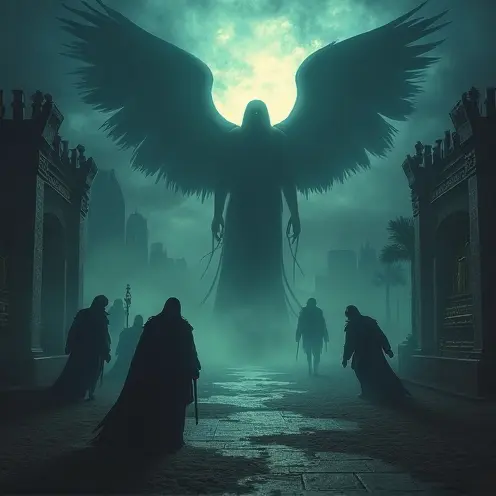The Bible, often revered for its profound spiritual lessons and inspiring stories of faith, also contains a number of narratives that delve into the darker and more supernatural aspects of human experience. These horror stories, while not as widely discussed as the more uplifting tales, offer a unique perspective on the nature of evil, divine justice, and the battle between good and evil.
One of the most chilling stories in the Bible is the account of the ten plagues of Egypt found in the Book of Exodus. These plagues were a series of divine punishments inflicted upon the Egyptians by God to convince Pharaoh to release the Israelites from slavery. The plagues began with relatively minor inconveniences, such as the Nile River turning into blood and the infestation of frogs. However, they escalated into far more horrifying events, including swarms of flies, boils that covered the skin, and the death of all the firstborn sons in Egypt. The final plague, the death of the firstborn, is particularly harrowing. It was a night of terror and mourning, as the angel of death passed over the land, sparing only those Israelite households that had marked their doorposts with the blood of a lamb. This story serves as a stark reminder of the consequences of defiance against God and the power of divine retribution.
Another eerie narrative is found in the story of King Saul and the Witch of Endor in 1 Samuel 28. Saul, the first king of Israel, had previously banned mediums and necromancers from his kingdom. However, in a moment of desperation, he sought the help of a medium to summon the spirit of the deceased prophet Samuel. The scene is filled with supernatural dread as the witch conjures up Samuel’s spirit, who appears as a ghostly figure. Samuel’s message to Saul is one of doom and judgment, foretelling Saul’s defeat and death in battle. The encounter leaves Saul trembling in fear, and the story highlights the consequences of seeking guidance from forbidden sources and the terrifying nature of the supernatural world.
The Book of Revelation, the final book of the New Testament, is a treasure trove of apocalyptic horror. It describes a series of catastrophic events that will unfold in the end times, including the opening of the seven seals, the sounding of the seven trumpets, and the pouring out of the seven bowls of wrath. These events bring about natural disasters, plagues, and the rise of terrifying beasts. One of the most unsettling images is the description of the four horsemen of the Apocalypse, who symbolize conquest, war, famine, and death. Their arrival marks the beginning of widespread destruction and suffering. The book also describes the emergence of the Antichrist and the final battle between good and evil at Armageddon. The vivid and often grotesque imagery in Revelation serves as a warning of the ultimate consequences of sin and the need for repentance.
In the Old Testament, the story of the Philistines and the Ark of the Covenant in 1 Samuel 5-6 is another example of a horror story. The Philistines captured the Ark of the Covenant, a sacred object representing the presence of God, and brought it to their temple dedicated to the god Dagon. The next morning, they found the statue of Dagon lying face down before the Ark. When they restored the statue, it happened again, but this time the statue’s head and hands were broken off. This was followed by a plague of tumors and other disasters that struck the Philistine cities. The terror and suffering caused by the Ark’s presence forced the Philistines to return it to the Israelites. This story illustrates the power and holiness of God and the dire consequences of defiling or misusing sacred objects.
The story of King Nebuchadnezzar in the Book of Daniel also has elements of horror. Nebuchadnezzar, the powerful king of Babylon, experienced a series of troubling dreams and visions. In one instance, he was punished by God for his arrogance and pride. He was driven mad and lived like an animal, eating grass and crawling on all fours, for seven years. This transformation is a horrifying depiction of divine judgment and the humbling of a once-mighty ruler. The story serves as a cautionary tale about the dangers of hubris and the need for humility before God.
While these horror stories in the Bible may seem unsettling, they serve important purposes. They remind us of the reality of evil and the consequences of sin, while also highlighting the power and justice of God. They challenge us to reflect on our own actions and to seek a deeper understanding of the divine. These stories, though dark, are an integral part of the rich tapestry of biblical narratives that continue to inspire and instruct believers.
If you are interested in more exploring fascinating and thought-provoking stories from the Bible, visit https://storiesinthebible.com/ for a comprehensive collection of biblical stories and insights.

